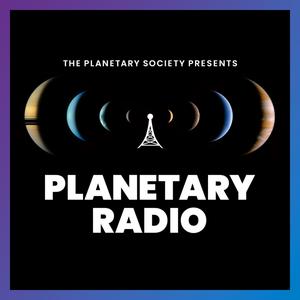
Starts With A Bang podcast
Ethan Siegel
The Universe is out there, waiting for you to discover it. There’s a cosmic story uniting us. We’re determined to bring it to everyone.
- 1 hour 37 minutesStarts With A Bang podcast #113 - Weird stars
When it comes to stars, most of them, for most of their lives, behave in a very similar fashion to the Sun. In their cores, they undergo nuclear fusion, which provides energy and creates radiation, and that outward radiation pressure holds the star up, internally, against gravitational collapse. For most stars, this balance between the pressure from outward radiation and the inward force from gravitation is nearly perfect all throughout the star, leading to an equilibrium state.
But some stars aren't in this kind of equilibrium at all. Instead, some internal process actually drives the star in a fashion that causes it to pulsate: overshooting equilibrium in both directions, as it alternatingly expands and cools, and then contracts and heat up in a cyclical fashion. These species of intrinsic variable stars, including Cepheids and RR Lyrae stars, are not only of profound importance when it comes to understanding stellar evolution, but for unlocking the secrets of the distant Universe.
How do we understand these stars today, where are the frontiers, and what do we hope to learn about them in the coming years and decades? Especially as we transition into the era of "big data" in astronomy, where we aren't observing individual stars in detail but rather thousands upon thousands of similar stars all at once, the answers to these questions are rapidly changing. I'm so pleased to share the first episode of 2025 with you, featuring our guest, Ph.D. candidate Catherine Slaughter, who takes us through all this and more. It's a fascinating look into stellar physics, with possible implications for our own Sun's fate, that you won't want to miss!
(The featured image shows the star RR Lyrae, as imaged by the digitized sky survey back at the turn of the century, using data from the Palomar and UK Schmidt telescopes. Credit: Digitized Sky Survey - STScI/NASA)
11 January 2025, 2:00 pm - 1 hour 28 minutesStarts With A Bang #112 - Galactic Archaeology
When we look out at our home galaxy, the Milky Way, we have to recognize that even though it's been growing and evolving for 13.8 billion years, we're only observing it as it is right now: a snapshot in time determined by the light that's arriving in our instruments right now. However, just like we're living "right now" in human history but can, through the science of archaeology, learn about historical events that happened many thousands of years ago (before recorded history) or even earlier, we can learn about the Milky Way's history through the astronomical equivalent: galactic archaeology.
How do galactic archaeologists do it? They look at as much data as possible, across many wavelengths of light, including at many rare and obscure species of stars, in as many locations as possible and to the greatest precisions possible all at once. By combining these different lines of evidence, we can arrive at a coherent and compelling picture for how our little corner of the Universe grew up, including by reconstructing the merger history of the Milky Way.
Surprisingly, it isn't only the "big data" missions that are contributing to this understanding, but even smaller, less heralded (and more accessible) telescopes, with the right equipment and sets of observations, can make a huge impact. Join us for this episode, where astrophysicist and observatory director Elaina Hyde joins us, helping us better appreciate the wonders of our own cosmic past!
(This illustration of our Milky Way shows an ancient galactic stream wrapped around our galaxy's plane at nearly a 90 degree angle: evidence for a recent and even ongoing merger in our galaxy's history. Credit: NASA/JPL-Caltech/R. Hurt (SSC/Caltech))
7 December 2024, 5:39 pm - 1 hour 36 minutesStarts With A Bang #111 - Black Hole Jets
In this Universe, there are a few objects that are just larger, and a few events that are just more powerful, than others. As far as size goes, the cosmic web creates some of the largest features ever discovered, with the largest galaxy filaments and the largest regions devoid of galaxies spanning as much as ~2 billion light-years. No robust, verified structure has ever been found that's larger. Meanwhile, as far as energy and power go, collisions of galaxy clusters are the most energetic events, outstripped only by the Big Bang itself.
However, nearly rivaling galaxy cluster collisions are the strongest black hole jets ever seen, capable of emitting trillions of times the energy of a Sun-like star, but also capable of sustaining those energies over timescales of a billion years or more. Astronomers have just set a new record for the longest black hole jet with the discovery of Porphyrion, which spans a whopping 24 million light-years across! How did this jet and others like it come to be, and what effects do they have on the larger Universe, and how do they get generated from such physically small objects (i.e., black holes) to begin with?
That's the subject of the latest edition of the Starts With A Bang podcast, featuring Dr. Martijn Oei: the discoverer of Porphyrion himself! We get deep into the physics and astrophysics of black holes and their jets, which have profound implications for how structures get carved and magnetized onto the scales of the cosmic web itself. Buckle up and tune in; it's a wild ride ahead!
(This illustration shows how black hole jets can be as large as the scale of the cosmic web itself, with Porphyrion, as illustrated here, setting a new cosmic record with its bipolar jets spanning 23-24 million light-years across. Credit: Erik Wernquist/Dylan Nelson (IllustrisTNG collaboration)/Martijn Oei; Design: Samuel Hermans)
9 November 2024, 5:22 pm - 1 hour 40 minutesStarts With A Bang #110 - Optical Interferometry
It's hard to imagine, but it was only five years ago, in 2019, that humanity feasted our collective eyes on the first direct image of a black hole's event horizon. Thanks to the technique of very long baseline interferometry and the power of arrays of radio telescopes stitched together from all across the Earth, we were able to resolve the event horizon of the black hole M87*, despite the fact that it's an impressive 55 million light-years away.
That was with radio interferometry, but historically, most telescopes have used optical light, not radio light. Does that mean that optical interferometry is possible? Not only is the answer a resounding "yes," but we've been performing it for decades. In fact, the most ambitious optical interferometry project of all-time is already under construction in New Mexico: the Magdalena Ridge Observatory Interferometer (MROI). With an array that will feature a total of ten separate telescopes all linked together, and with a maximum tunable distance of 340 meters between them, it's poised to achieve higher-resolution imagery of a suite of astronomical objects than has ever been obtained before, from the ground or from in space.There's so much mind-blowing science to learn that we had to bring two guests onto our podcast this month to explain it all: Dr. Michelle Creech-Eakman of New Mexico Tech and Dr. Chris Haniff of Cavendish Laboratory at Cambridge University. Be prepared for a fascinating look at the science of optical interferometry, what we'll be able to discover once MROI is complete, and an incredible tour of the instrumentation science that powers it. It's a fascinating episode you won't want to miss!
(The first two telescopes (of ten) that will eventually be part of the Magdalena Ridge Observatory Interferometer when its full array is complete. Credit: James Luis/MROI)
6 October 2024, 8:36 pm - 1 hour 29 minutesStarts With A Bang #109 - Launching a galactic cone
When you think of an active galaxy, what picture comes to mind? Do you think about a monstrous supermassive black hole feasting on tremendous stores of gas and other forms of matter? Do you picture an enormous disk of accreted matter, being accelerated, heated, and eventually shot out along two jets, each perpendicular to the disk itself? This common picture of active galaxies describes many of the most prominent ones, but isn't universal to them all.
Some active galaxies aren't giant ellipticals, but just average-looking spiral galaxies. Some galaxies aren't in the process of a major merger, but seem to be powered by their own internal gas. And some of these black holes aren't ridiculously massive, with billions of solar masses inherent to them, but are rather much more modest. Some of these active galaxies actually show practically no signs of activity in visible light, but must be viewed in other wavelengths, such as with radio telescopes, to reveal their activity.
Above, you can see galaxy NGC 3227, which may appear to be just a normal spiral galaxy. However, not only is it active, but it's actively in the process of launching a "cone" of energetic material from very close to the black hole itself. Here to help us untangle its mysteries and take us on a deep dive into the physics of these objects, I'm so pleased to welcome Julia Falcone to the podcast. Julia is a PhD candidate at Georgia State University, and her very first published first-author paper is about this exact system shown here. Come join us as we explore these fascinating objects and open a window onto the Universe we're still discovering!
(This image shows galaxy NGC 3227, at left, with its neighbor NGC 3226, as viewed in optical light by the Hubble Space Telescope. Despite copious features common to spiral galaxies, including rich dust lanes, a bright central bulge, and new stars forming along its spiral arms, this galaxy is actually active, with bright features emanating from the central supermassive black hole in non-optical wavelengths of light. Credit: NASA, ESA, and H. Ford (Johns Hopkins University); Image Processing: G. Kober (NASA Goddard/Catholic University of America))
7 September 2024, 4:20 pm - 1 hour 38 minutesStarts With A Bang #108 - A Future Particle Collider
Right now, the Large Hadron Collider (LHC) is the most powerful particle accelerator/collider ever built. Accelerating protons up to 299,792,455 m/s, just 3 m/s shy of the speed of light, they smash together at energies of 14 TeV, creating all sorts of new particles (and antiparticles) from raw energy, leveraging Einstein's famous E = mc² in an innovative way. By building detectors around the collision points, we can uncover all sorts of properties about any known particles and potentially discover new particles as well, as the LHC did for the Higgs boson back in the early 2010s.
But the LHC has a limited lifetime, and by the 2030s, will complete its data-taking runs. If we want to go beyond the LHC, we need to start planning for a new particle collider now, and there are four great options that can take us beyond the current frontier: a linear lepton collider, a circular lepton collider, a circular hadron collider, and a potentially new innovation of a circular muon collider. In this episode of the Starts With A Bang podcast, Dr. Cari Cesarotti joins us to discuss all of these options and much more, as we look ahead to the future of particle physics.
The serious question isn't whether we should build one (we definitely should), but which approach will be most fruitful in pushing our suite of knowledge beyond the known frontiers. There's an entire Universe to explore at the subatomic level, and those of us curious about the Universe want to know what's out there better than ever before!
(This image shows the expected signature of a Higgs boson decaying to bottom-quark jets around the collision point inside a muon collider. The yellow lines represent the decaying background of muons, while the red lines represent the b-quark jets. Credit: D Lucchesi et al.)3 August 2024, 2:00 pm - 1 hour 52 minutesStarts With A Bang #107 - Binary Stars And Modified Gravity
On the largest of cosmic scales, the best description we have of our Universe is known as the ΛCDM model with an inflationary hot Big Bang: our consensus cosmology. It tells us that we have a Universe consistent with being made of about 5% normal matter, a little bit of radiation in the form of photons, around 0.1% neutrinos, and the rest made of the mysterious dark matter (~27%) and dark energy (~68%). Governed by General Relativity, this explains what we see on Solar System scales, where dark matter and dark energy are negligible, and on cosmic scales, where dark matter and dark energy are important.
But on in-between scales, we aren't quite sure that this same "consensus cosmology" leads to a very successful description. It's long been known that, on galactic scales, rotating galaxies appear to obey a different force law: MOND, for MOdified Newtonian Dynamics. In MOND, the traditional Newtonian acceleration is replaced, at very low accelerations, by a combination of the Newtonian acceleration with a fundamental new parameter, which prevents accelerations from dropping too far below a certain value: around ~10^-10 meters-per-second-squared. If this deviation is real, it should show up someplace else: in pairs of stars separated by large distances, a class of systems known as wide binaries.
Although this area of physics was widely ignored for decades, new observations with the ESA's Gaia mission have recently brought it back into the forefront, where different teams are claiming different results based on how they use and interpret the data. In this rare edition of the Starts With A Bang podcast, I sit down with astrophysicist Xavier Hernandez of UNAM in Mexico, who's one of the main players in this story and a strong advocate of MOND as an alternative to dark matter. The conversation takes many interesting turns and as a result, we've got a great episode that's nearly two hours long. (Although there is some confusion over the maximum distance that Xavier's sample goes out to in the podcast: the correct answer is not mentioned, but turns out to be ~12,000 AU, not the 6000 or 16,000 mentioned in the podcast.) Take a listen, learn some new astrophysics, but most importantly, stay open to new challenges to the conventional paradigm. If there's a crack in our consensus cosmology, this area of astrophysics might someday be the critical blow that shatters it apart!
(This photo shows the bright, naked-eye star, Albireo. To the naked eye, it appears as just a single point of light. However, a binocular or telescope view shows that it's actually two very different colored stars separated by a substantial fraction of a light year: a wide binary system. Even thousands of years after its identification, we still don't know if this is a bound system, or two stars that happen to be passing one another in close proximity. Credit: Jared Smith/Flickr)
6 July 2024, 3:23 pm - 1 hour 33 minutesStarts With A Bang #106 - The Troublesome Hunt for Planet Nine
One of the most swiftly forgotten revolutions in all of science is our understanding of the Solar System out beyond Neptune. Although Pluto was discovered nearly a full century ago, it wasn't until the early 1990s that we even discovered the next object beyond Neptune that wasn't also part of the Plutonian system. And yet, in the 30 short years that have passed since then, we've learned so much more about the structure of the Kuiper belt and beyond, but we also face tremendous challenges in the quest to learn more thanks to an unwelcome intruder: the rise of satellite megaconstellations.
Although the original team of Mike Brown and Konstantin Batygin continue to advocate for a novel, massive, undiscovered world located at hundreds of times the Earth-Sun distance, they're largely alone, as other scientists have weighed in and see no evidence for this hypothetical world. Nevertheless, more science must be conducted to know for sure, and in the meantime, the rise of satellite megaconstellations such as Starlink now poses an existential threat to all sorts of endeavors, including planetary astronomy.
Here to guide us through the current status of the hunt for Planet Nine, as well as the new obstacles that astronomers are contending with, I'm so pleased to welcome Prof. Sam Lawler to the show. Sam is a professor at the University of Regina in Saskatchewan, Canada, and is also known for her advocacy work in favor of dark and quiet skies for all of humanity to enjoy and benefit from. It's a fascinating discussion that took me to some unexpected places, and I think you'll enjoy it a whole lot!
(This image shows an illustration of the hypothetical Planet Nine: a planet theorized to be more massive than Earth but hundreds of times farther away from the Sun than our own world. Credit: Tobias Roetsch/Future Publishing)
8 June 2024, 3:52 pm - 1 hour 38 minutesStarts With A Bang #105 - Dark Matter And Galaxies
Every January, I head to the American Astronomical Society's big annual meeting with an ulterior motive in mind. Beyond merely uncovering new scientific findings, gathering information for potential stories, and connecting with friends and colleagues, I also look to meet emerging junior researchers who are swiftly becoming not only experts, but leaders, in their particular sub-field of astronomy.
One of the most popular research topics in astrophysics today is the connection between the dark Universe, including the only indirectly-observed dark matter and dark energy, and the observable components that astronomers routinely see: stars, galaxies, gas, plasma, and other forms of light-emitting and light-absorbing matter. The dark Universe, to date, is best revealed by looking at the luminous, electromagnetic signals that are imprinted onto the visible components of our cosmos.
To better understand what scientists are investigating, I'm so pleased to welcome KeShawn Ivory to the podcast. KeShawn is a PhD candidate at Vanderbilt University and researches the connection between dark matter, the non-luminous, gravitationally interacting "stuff" that holds the Universe together (as best as it can), and the luminous, observable galaxies that populate the visible Universe in numbers that rise into the trillions. It's a fascinating topic and a great addition to your May listening, right here on Starts With A Bang!
(The SIBELIUS project, which simulates galaxies and structures beyond the local Universe, is part of the Virgo Consortium that attempts to use cosmological simulations to reproduce features of galaxies, groups, and clusters that are seen all across the Universe. By using a mix of theory, observations, and simulations, astrophysicists can better understand the nature of dark matter in our cosmos. Credit: Virgo Consortium/SIBELIUS project)
11 May 2024, 3:14 pm - 1 hour 42 minutesStarts With A Bang #104 - The Magnetized Galactic Center
Have you ever wondered what the full story with the galactic center is? Sure, we have stars, gas, and an all-important supermassive black hole, but for hundreds of light-years around the center, there's a remarkable story going on that's traced out in a variety of elements at a whole slew of different temperatures. Imprinted in that material is a remarkable set of features that reveals the magnetic fields generated in our galaxy's core, with some of them spanning much greater distances than have ever been seen elsewhere.
It's a testament to the power of multiwavelength astronomy, and in particular to the long wavelengths like the far-infrared, the microwave, and the radio portions of the spectrum that shows us these features of the Universe that simply can't be revealed in any other way. To help bring this story to all of you, I'm so pleased to welcome Dr. Natalie Butterfield, a scientist at the National Radio Astronomy Observatory (NRAO), to join us on this episode of the Starts With A Bang podcast.
Natalie is the discoverer of a giant magnetized ring some 30 light-years in diameter located in the galactic center, and is one of the leaders of the FIREPLACE survey: the Far-Infrared Polarimetric Large-Area CMZ Exploration survey that used the (sadly, now-defunct) SOFIA telescope to image the galactic center as never before. Strap in and have a listen, because you just might never think about the core of the Milky Way in the same way again!
(This image shows the magnetized galactic center, with various features highlighted, as imaged by the SOFIA/HAWC+ FIREPLACE survey team. The giant bubble at the left of the image is some 30 light-years wide, several times larger than any other supernova-blown bubble ever discovered. Credit: D. Paré et al., arXiv:2401.05317v2, 2024)
5 April 2024, 11:00 am - 1 hour 30 minutesStarts With A Bang #103 - Active galaxies and the universe
All throughout the Universe, galaxies exist in a great variety of shapes, ages, and states. Today's galaxies come in spirals, ellipticals, irregulars, and rings, all ranging in size from behemoths hundreds or even thousands of times larger than the Milky Way to dwarf galaxies with fewer than 0.1% of the stars present here in our cosmic home. But at the centers of practically all galaxies, particularly the large ones, lie supermassive black holes.
When matter falls in towards these black holes, it doesn't just get swallowed, but accelerates and heats up, leading to phenomena like accretion disks, jets, and emitted radiation all across the electromagnetic spectrum. When these conditions exist, we know we have what's called an active galaxy, and it isn't just the rest of the galaxy that's impacted by that central activity, but far larger structures in the Universe beyond.
Here to help us explore these objects and their impact this month is Skylar Grayson, a PhD candidate at the School of Earth and Space Exploration at Arizona State University. Skylar works at the intersection of theory and computational astrophysics, and helps simulate the Universe while focusing on the inclusion and modeling of this type of galactic activity, and is one of the people helping uncover just how profound of a role these galaxies play in shaping the Universe around them. Buckle up for another exciting 90 minute episode; you won't want to miss it!
The powerful radio galaxy Hercules A, shown above, is a stunning example of how central activity from the galaxy's active black hole influences not only the host galaxy, but a large region of space extending far outside the galaxy itself, as visible from the extent of the radio lobes highlighted visually. (Credit: NASA, ESA, S. Baum and C. O'Dea (RIT), R. Perley and W. Cotton (NRAO/AUI/NSF), and the Hubble Heritage Team (STScI/AURA))
9 March 2024, 4:19 pm - More Episodes? Get the App
Your feedback is valuable to us. Should you encounter any bugs, glitches, lack of functionality or other problems, please email us on [email protected] or join Moon.FM Telegram Group where you can talk directly to the dev team who are happy to answer any queries.
 Into the Impossible With Brian Keating
Into the Impossible With Brian Keating
 Sean Carroll's Mindscape: Science, Society, Philosophy, Culture, Arts, and Ideas
Sean Carroll's Mindscape: Science, Society, Philosophy, Culture, Arts, and Ideas
 Why This Universe?
Why This Universe?
 Universe Today Podcast
Universe Today Podcast
 Planetary Radio: Space Exploration, Astronomy and Science
Planetary Radio: Space Exploration, Astronomy and Science
 Ask a Spaceman!
Ask a Spaceman!